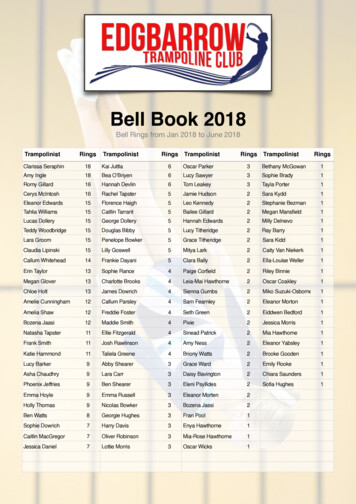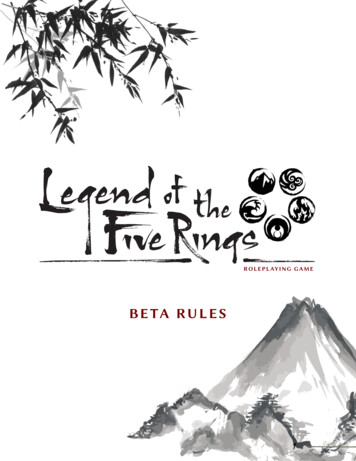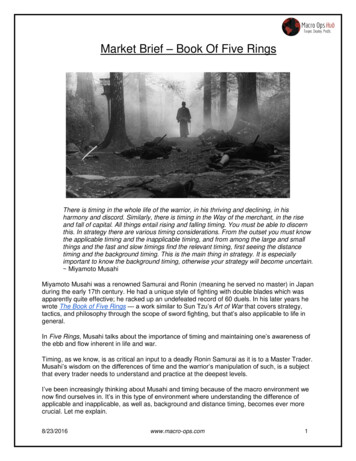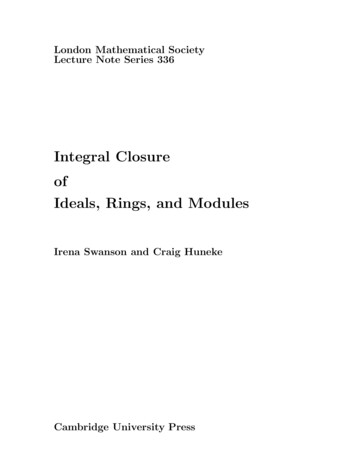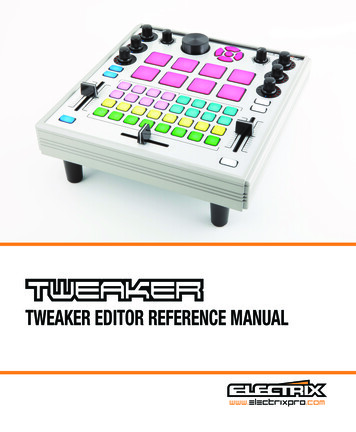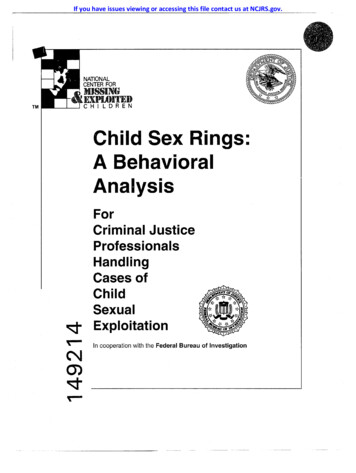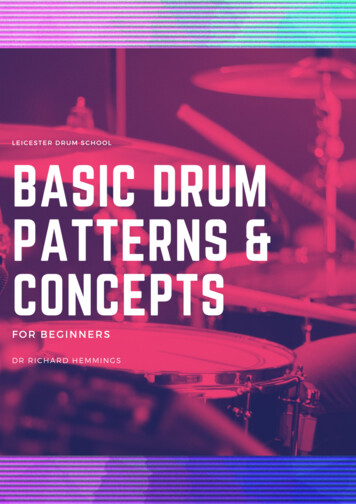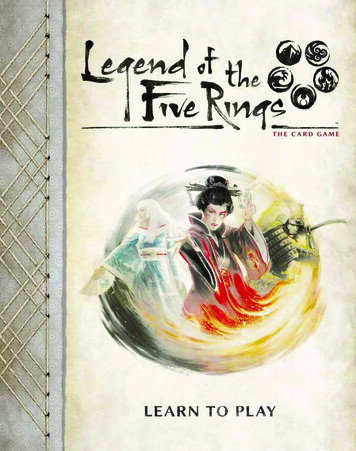
Transcription
TM
An Empire in Turmoil.Game OverviewLegend of the Five Rings: The Card Game is a twoplayer game in which each player takes the role of oneof the seven Great Clans of Rokugan. In the game,players vie for political and military dominance whilesimultaneously observing the strict codes of conductthat preserve their honor. Each player commands theirforces from two different decks: a dynasty deck thatfills their provinces with characters and holdings, and aconflict deck consisting of tactics, maneuvers, and tricksthat can be used to turn the tide of a conflict.“There! Do you see that?” Doji Kuwanan’s armor,lacquered in the blue and silver colors of the CraneClan, clinked as he pointed to the thin column of dustrising along the horizon where plains met sky.His patrol partner, Takeaki, shielded his eyes from thebright glare of the sun and squinted. “A merchant’scart? The spring rains are late this year,” he said, kickingup dust of his own under his armored zori sandals.Around them, birdsong mixed with the chants anddrumming of the peasants as they rhythmically tilled thesoil and spread seeds atop the furrowed earth. A coolbreeze brought the earthy smell of fertilizer to the pair ofsamurai warriors and sent ripples across the plains.Kuwanan shook his head. “There’s too much dust fora single cart. And no caravan’s due for weeks yet.” Hehurried atop the nearby arched bridge to get a betterlook. A blur of dark brown silhouettes emerged frombehind a gently sloping hill, speeding toward them.Dynasty Card Back“Quiet!” Kuwanan bellowed at the farmers, who ceasedtheir dance of sowing and planting in an instant. Thedistant thunder of galloping hooves soon overtook thesound of chattering birds, and Takeaki muttered a curse.Conflict Card BackDuring a game, players engage in conflicts against theiropponent’s provinces in an attempt to break them.The first player to break the province that holds theiropponent’s stronghold wins the game. However, theplayers must also monitor their honor as they contestone another, for it is possible for a player to win byachieving a high degree of honor, or to run out of honorand shamefully lose the game.“Someone’s coming! Get back to the village!” Kuwananshouted, and the peasants scrambled up to the road.He and Takeaki strung their bows and took up defensivepositions atop the bridge. “If the Lion are finallymounting an attack, let them try to take this village fromus!” He nocked an arrow and prepared to take aim.2
Using this BookThis Learn to Play book is written as an introduction toLegend of the Five Rings: The Card Game. It shouldbe used as a guide for new players while learning andplaying the first game. The first part of this book takesplayers through an entire game round, teaching therules and introducing the strategy of the game alongthe way.After players have learned the basics of the game, theywill be ready to enrich their experience by building theirown original decks. The rules for doing so are includedon page 18.The latter part of this book contains an introduction tothe Rokugan setting and the seven Great Clans featuredin this core set. Finally, three appendices are included asa reference for a number of advanced topics, frequentlyasked questions, and card anatomies.A comprehensive Rules Reference can be foundonline at www.fantasyflightgames.com/L5R. Thatdocument addresses more advanced topics such asthe interpretation of card text, the resolution of timingconflicts, and a detailed phase sequence timing chart.It is recommended that new players become familiarwith the game using the Learn to Play book and onlylook up details in the Rules Reference as they occurduring play.A Living Card GameLegend of the Five Rings: The CardGame is a two-player game that can beplayed using just the contents of thiscore set.In addition, Legend of the Five Rings:The Card Game is a Living Card Game (LCG ). Its experience can be customizedand enhanced through the purchase ofregularly released 60-card expansionscalled Dynasty Packs. Unlike collectiblecard games, all LCG expansionshave a fixed distribution: there is norandomization to their contents.3
ComponentsThe components in the game are presented here foridentification purposes. A complete card anatomycan be found in “Appendix III: Card Anatomy” onpage 32.Imperial Favor25 Shizuka ToshiSTRONGHOLD1 Pilgrimage 2017 FFG 220APROVINCEDuring conflicts at this province, cancel all ringeffects. (If this province breaks, resolve ringeffects as normal.)1 Imperial FavorCard (double-sided)20 Status Tokens(double-sided)City.Action: During a conflict, bow this stronghold.Choose a participating character with skill 2 orlower – bow that character.711ILLUS. ALAYNA LEMMER10 2017 FFG27 Stronghold Cards40 Fate Tokens ILLUS. NELE DIEL 2017 FFG2217 Province Cards1 First Player Token50 Honor Tokens2Brash SamuraiCHARACTER212Bushi.Action: While this character is your only participatingcharacter in a conflict – honor this character.A samurai lives at all times three feet from death.Keeper of AirKeeper. Air.2 Honor DialsIncrease your deckbuilding influence value by 3.Reaction: After you win an conflict as thedefending player – gain 1 fate.ILLUS. CALVIN CHUA 2017 FFGD 42117 Dynasty Cards2 2017 FFG 214A5 Role Cards(double-sided)Dial AssemblyAssemble each honor dial by using theplastic dial connectors to attach thedial to the faceplate, as shown in thediagram below.Conflict Ring EffectsVengeful OathkeeperCHARACTERAir – The attacking player takes1 honor token from his or heropponent, or gains 2 honor.21Earth – The attacking player draws1 card from his or her conflict deckand discards 1 card at random fromhis or her opponent’s hand.Fire – The attacking player choosesa character in play and honors ordishonors that character.0Bushi.Reaction: After you lose a conflict – put thischaracter into play from your hand.“When a samurai has said he will perform an action, it is asgood as done.” – Akodo’s LeadershipILLUS. DARREN TAN 2017 FFGC 16098 Conflict Cards5 Ring Tokens(double-sided)Water – The attacking player eitherchooses a character and readies it, orchooses a character with no fate on itand bows it.Void – The attacking player maychoose a character and remove1 fate from it. MilitaryPolitical 2017 FFG 219B2 Reference Cards(double-sided)4
Key ConceptsReady and BowedCards enter play in a ready position (upright, so thatthe card’s text may be read from left to right). At theend of a conflict, or in order to use certain card abilities,cards will bow, which is indicated by rotating a card 90degrees (sideways). A bowed card indicates that a cardhas been used, and a card is not able to bow again untilit is readied by a game step or card ability.This section introduces a number of foundationalconcepts to keep in mind while learning and playingthe game.The Jade RuleIf the text on a card directly contradicts the text of therules, the text on the card takes precedence.5Winning and Defeat Akodo ToturiCHARACTER5 Akodo ToturiD 79ReadyDuring the game, players declare attacks against oneanother’s provinces, and successful attacks can result ina province breaking.CHARACTER633 2017 FFGBushi. Champion.ILLUS. SHAWN IGNATIUS TANReaction: After you claim a ring during a conflictin which this character is participating – resolve thatring’s effect.A lion is more than his roar, his mane, his teeth, his heart.A lion is all of these.A player’s province cards represent a variety ofcircumstances and occurrences in the lands under thecontrol of the Great Clans of Rokugan.D 79Provinces and Strongholds3 2017 FFGBushi. Champion.Reaction: After you claim a ring during a conflictin which this character is participating – resolve thatring’s effect.A lion is more than his roar, his mane, his teeth, his heart.A lion is all of these.ILLUS. SHAWN IGNATIUS TAN63There are three ways by which a player can win thegame: break the province which holds their opponent’sstronghold, accumulate 25 honor, or have theiropponent run out of honor.BowedFateFate is the game’s primary resource,representing the karma and destiny aclan has accrued. The primary use offate is to spend it to play cards.If three of a player’s four non-stronghold provinces arebroken, attacks may be declared against that player’sstronghold province. As soon as a player’s strongholdprovince is broken, that player loses the game.In addition, after a character is played, its controllermay place any additional number of fate tokens fromtheir fate pool on that character. Each fate token on acharacter allows that character to remain in play for anadditional game round.Strategy: Break Their Provinces!Within the core set, breaking an opponent’sprovinces is the most common victorycondition, and new players are advised toconcentrate primarily on this method ofwinning while learning the basics of the game.During the fate phase (see”Phase 4: Fate” on page16) each character that has no fate tokens on it isdiscarded. One fate token is then removed from eachremaining character.In Player OrderThe phrase “in player order” is used to dictate theorder in which players resolve or execute a game step.When players are instructed to do something in playerorder, the first player does so first, followed by theother player.Honor and DishonorHonor represents both the behavior ofa player’s clan, as well as the outwardperception of that behavior. Players beginthe game with the amount of honordesignated by their stronghold card.Various effects in the game cause honor to be gained,exchanged between players, or lost. If a player has 25or more honor in their pool, that player immediatelywins. If a player has no honor in their pool, that playerimmediately loses.Triggered Card AbilitiesMany card abilities (such as actions, interrupts, andreactions) are triggered voluntarily by the playersthroughout the game. Unless an ability specifiesotherwise, it may be used once each round. For more oncard abilities, see page 29.5
Game Setup2. Create Token Pool and Ring PoolPlace all fate tokens, honor tokens, status tokens, andthe Imperial Favor card in a pile within reach of eachplayer. This area is known as the general token pool.Place the rings in a pile within reach of each player. Thisarea is known as the unclaimed ring pool.To set up the game, perform the following steps,in order:1. Select DecksFor the first game, each player selects one set of starterdecks described below. Each card’s collector number,which is used in the decklists below, is located in thelower right corner of the card. Crane Clan starter decks: This deck uses ShizukaToshi (2) as its stronghold, and the provinces TheArt of Peace (9), Entrenched Position (17), NightRaid (21), Rally to the Cause (23), and ShamefulDisplay (24).Imperial Favor1 The Crane dynasty deck uses all of the Cranedynasty cards (40–53), one copy each of the neutralcards Otomo Courtier (122), Miya Mystic (125),Favorable Ground (128), Imperial Storehouse (129),and two copies each of the neutral cards SeppunGuardsman (123) and Wandering Ronin (127). 2017 FFG 220A3. Determine First PlayerRandomly select a player to be the firstplayer. Place the first player token infront of this player. The other playergains 1 fate from the general tokenpool and adds it to their fate pool.The Crane conflict deck uses all of the Crane conflictcards (139–148), and one copy each of the neutralcards (200–213).4. Shuffle Dynasty and ConflictDecks Lion Clan starter decks: This deck uses Yōjin noShiro (4) as its stronghold, and the provinces TheArt of War (11), Ancestral Lands (15), ManicuredGarden (19), Meditations on the Tao (20), andPilgrimage (22).First PlayerTokenEach player shuffles both their dynasty and conflictdecks separately until the decks are sufficientlyrandomized and presents them to the opponentfor a final cut. Each player then places their dynastydeck to the left of their play area and their conflictdeck to the right.The Lion dynasty deck uses all of the Lion dynastycards (67–80), one copy each of the neutral cardsSeppun Guardsman (123), Wandering Ronin (127),Favorable Ground (128), Imperial Storehouse (129),and two copies each of the neutral cards OtomoCourtier (122) and Miya Mystic (125).5. Place Provinces and StrongholdEach player secretly selects one of their provinces,places it facedown above their dynasty deck, and placestheir stronghold card on top of it. Each player thenplaces their other four provinces facedown betweentheir dynasty and conflict decks, in any order. Eachplayer places one honor dial near their conflict deck.The Lion conflict deck uses all of the Lion conflictcards (160–169), and one copy each of the neutralcards (200–213).6. Fill ProvincesEach player places one card from thetop of their dynasty deck facedownonto each of their empty nonstronghold provinces. Players will havethe opportunity to play these cards fromtheir provinces during the game round.6Dynasty DeckCardback
2 Shizuka ToshiAfter placing these cards during setup, each playerhas one opportunity to look at their facedown cards,choose which ones they wish to keep, and replace therest (known as a mulligan). Set aside the cards to bereplaced and deal a new facedown card into each emptyprovince. Then shuffle the replaced cards back into thedynasty deck.After drawing these cards, each player has oneopportunity to look at the cards in their hand, choosewhich ones they wish to keep, and replace the rest(known as a mulligan). Set aside the cards to bereplaced and draw an equivalent number of new cardsfrom the conflict deck. Then shuffle the cards set asideback into the conflict deck.Note: After this point, players are not permitted to lookat facedown cards in their provinces.8. Gain Starting HonorSTRONGHOLDEach player gains honor tokensequal to the honor valueCity.indicated inthe Duringlowera leftcornertheirstronghold.Action: conflict,bowofthisstronghold.7. Draw Starting HandChoose a participating character with skill 2 or– bowthat character.The game loweris nowreadyto begin.Each player draws four cards from theirconflict deck to form their starting hand.These cards are typically used duringthe conflict phase to help playerswin conflicts.711Conflict DeckCardbackILLUS. ALAYNA LEMMER10 2017 FFG2Honor Valueon StrongholdSuggested Play Area (Crane Player, mid-game)First PlayerTokenOpponent’s Play AreaStrongholdFate Pool22 Shizuka ToshiSTRONGHOLD2Cautious ScoutSavvy PoliticianCHARACTERCHARACTER2012Honor Pool and Honor DialHome Area1Bushi. Scout.City.Action: During a conflict, bow this stronghold.Choose a participating character with skill 2 orlower – bow that character.Courtier.For each of her accomplishments,she deferred the praise to those around her,and in this manner their loyalty was secured.They told him to be careful,but there was only one way to know for sure.11ILLUS. ALAYNA LEMMER710 2017 FFGILLUS. SERGIO CAMARENA 2017 FFG1Reaction: After this character is honored, choose acharacter – honor that character.While this character is attacking alone, treat thedefending province as if its printed text box wereblank (except for Traits).D 43ILLUS. POLAR ENGINE 2017 FFGD 45223Brash SamuraiCHARACTERCHARACTER2133Doji Challenger2Bushi.Bushi. Duelist.Action: While this character is your only participatingcharacter in a conflict – honor this character.2Action: While this character is attacking, choosea character controlled by your opponent – movethat character to this conflict.A samurai lives at all times three feet from death.“I hope you are prepared to defendyour words with steel!”DynastyDiscardDynastyDeckILLUS. CALVIN CHUA 2017 FFGD 42ILLUS. ZEZHOU CHENNon-StrongholdProvinces7 2017 FFGD 47ConflictDeckConflictDiscard
Phase SequencePlaying a Character from a ProvinceIn order to play a character from a province, a playermust first pay that card’s cost (indicated in the upperleft corner of the card) by spending that much fate fromtheir fate pool to the general token pool. Next, movethat card from the province into that player’s home area– the part of the play area in front of their provinces. Allcharacters enter play in a ready position.Legend of the Five Rings: The Card Game is playedover a series of rounds. During a round, players bringnew characters into play from their provinces, decidehow honorably they will act in the coming conflicts,declare military and political conflicts against oneanother’s provinces, check the fate of their characters,and regroup in preparation for the next round. Eachround is divided into the following five phases:After a character is played, its controller has the optionof placing any number of fate tokens from their pool onthat character. Placing fate on a character will keep thatcharacter in play for additional game rounds.1. Dynasty2. Draw3. ConflictCard cost5 Akodo ToturiCHARACTER634. Fate5. RegroupEach phase is described in detail, below.Phase 1: DynastyBushi. Champion.3Reaction: After you claim a ring during a conflictin which this character is participating – resolve thatring’s effect.The dynasty phase represents the clans’ attempts tomarshal their forces and allocate resources fromtheir provinces.A lion is more than his roar, his mane, his teeth, his heart.A lion is all of these.ILLUS. SHAWN IGNATIUS TANThe dynasty phase consists of three steps: 2017 FFGAdditional fatemay be placed ona character afterpaying its cost.D 79Once the option to place fate tokens on a character hasbeen completed or passed, the province from whichthe character was played is refilled by taking a cardfrom the dynasty deck and, without looking at the card,placing it facedown on the province.Step 1. Reveal Facedown Cards in ProvincesEach player, in player order, turns all facedown dynastycards in their provinces faceup. This process starts froma player’s leftmost province that has a facedown card onit and proceeds to the right. Note: Character cards inprovinces are not yet in play, and players will not be ableto use those characters until they are played during step3, below.Strategy: Placing Additional FatePlacing additional fate on a character is aninvestment in that character’s future impactupon the game. The best way to leverage thisimpact is to invest in your most powerful andimportant characters. Placing three fate on acharacter with a cost of one grants you threeadditional turns of one-cost impact, whileplacing the same three fate on a character witha cost of four grants you three additional turnsof four-cost impact. Being able to maximizethe impact of each additional fate that is spentis an important strategic concept in the game.Step 2. Collect FateEach player collects fate equal to the fate value on theirstronghold card. Other cards may also modify the amountof fate a player collects each turn.Step 3. Play Characters from ProvincesIn player order, players alternate opportunities to doone of the following: play a character card from theirprovinces, trigger an appropriate card ability (see page30), or pass. Note: At this time, a player cannot playattachment or character cards from their hand.Also keep in mind: any fate a player does notspend remains in that player’s pool from roundto round. So, if you have extra fate that youdon’t have an immediate use for, hold on to it,as it could prove useful later in the game.The first player to pass gains 1 fate. This player forfeitsthe opportunity to play characters from provinces ortrigger actions for the remainder of the phase. Theremaining player continues to play characters andtrigger actions alone until they also pass. Once bothplayers have passed, play proceeds to the draw phase.8
Phase 2: DrawHoldingsHoldings are a cardtype that represents the lands,structures, fortifications, and other locations that may befound in a player’s provinces.The draw phase represents the plotting and scheming ofthe Clans as they prepare for the conflicts ahead.Holding cards in a player’s provinces are not played.A holding modifies the defense strength of a provincewhen it is attacked, and is active as long as it remainsfaceup in the province.5In this phase, each player determines how honorablythey intend to act during the upcoming phases of theround: essentially, they are bidding their honor in orderto draw more cards from their conflict deck. Thesecards, kept in a player’s hand, represent secret agendas,surprising tactics, tricks, schemes, andhidden information.PilgrimagePROVINCEThe draw phase consists of 4 steps:During conflicts at this province, cancel all ringeffects. (If this province breaks, resolve ringeffects as normal.)1Imperial.Action: Sacrifice this holding – draw1 card.2. Each player reveals their selection.3. The player who selected the higher number givestheir opponent an amount of honor equal to thedifference between the two selected numbers. Ifboth players selected the same number, no honoris given.Imperial StorehouseHOLDING1. Each player secretly selects a number between 1 and5 on their honor dial. ILLUS. NELE DIELILLUS. CHARLES URBACH 2017 FFG4. Each player draws a number of cards from theirconflict deck equal to the number they selected ontheir honor dial.22 2017 FFGOnce the above steps are complete, proceed to theconflict phase.D 129For example: Kristina, playing the Crane, secretlyselects the number 2 on her honor dial. Tom, playingthe Lion, also secretly selects a number on his dial. Onceboth players are ready, they simultaneously reveal theirdials. Kristina reveals her bid of 2, and Tom reveals abid of 5. Tom’s bid is 3 higher than Kristina’s, so he mustgive her 3 honor from his pool. Kristina then draws 2cards from her conflict deck (equal to her bid), and Tomdraws 5 cards from his conflict deck (equal to his bid).The Imperial Storehouse holding increases thedefense strength of the Pilgrimage province from5 to 6.Draw and RefillDuring a game, players are frequently instructedto “draw cards” and to “refill” provinces. Cardsare always drawn from a player’s conflict deck andadded to that players hand. Provinces are alwaysrefilled facedown from a player’s dynasty deck.Running Out of CardsIf a player attempts to refill a card onto a province fromtheir dynasty deck or draw a card from their conflictdeck and no cards remain in the deck, that player loses5 honor, then shuffles the corresponding discard pileand places it facedown to form a new dynasty or conflictdeck. That player then continues to refill the province ordraw a conflict card.9
Each conflict is identified in two ways: by element andby type.Strategy: Honor BidsThere are several things to consider whendetermining how best to bid.ElementThere are five different elements in Legend of the FiveRings: The Card Game - Air, Earth, Fire, Water, andVoid. If the attacker wins the conflict they will gain areward, known as a ring effect, based on the conflict’selement. Each element provides a different ring effect,which will be described later.First, are you happy with the cards in yourhand? Do they seem that they will be usefulin the upcoming round? If you like your hand,you might consider bidding low to preserve oracquire more honor. If you feel that you needmore options, you might consider biddinghigh to draw more cards.TypeThere are two types of conflicts: military and political.A conflict’s type determines whether characters usetheir military or political skill value when resolvingthat conflict (see image, below).Second, consider how much honor you andyour opponent each have, and be wary ofhigh bids that could push your opponent tooclose to winning the game.Each player is permitted to declare one conflict of eachtype during the conflict phase.Third, try to anticipate your opponent’s mostlikely bid, and think about whether you’dlike to match that bid (to prevent honorfrom changing hands) or bid differently (tocreate more of an imbalance between youand your opponent in terms of honor or cardadvantage).Conflict OpportunitiesStarting with the first player and alternating back andforth, each player has the opportunity to declare aconflict against one of their opponent’s provinces. Eachplayer is permitted two such opportunities during thisphase, in the order listed below:Finally, think about whether you (and youropponent) are in a position from which youcould leverage more cards to influence thedirection of the game.1. The first player has the first opportunity to declareand resolve a conflict.2. The second player has the next opportunity todeclare and resolve a conflict.After considering all of the factors, make yourbid with confidence and see what happens— you can never know for sure what theopponent is going to do, and trying to bestnavigate this decision is one of the uniquestrategic moments of the game.3. The first player has another opportunity to declareand resolve a conflict.4. The second player has another opportunity todeclare and resolve a conflict.A player always has the option to pass on declaring aconflict during a conflict oppportunity, but doing sorelinquishes that conflict opportunity this phase.5Phase 3: ConflictCHARACTER63The conflict phase represents a series of military andpolitical confrontations between the two clans. A militaryconflict represents a military battle or a physical fight. Apolitical conflict could represent a trial, an argument ordebate, or a contest of court intrigue and scheming.In this phase, each player will have a chance to initiateconflicts against their opponent. After these conflictshave resolved, the players will compare glory in anattempt to earn the Imperial Favor.Military Skill (top) andPolitical Skill (bottom). Akodo Toturi5 Akodo ToturiCHARACTER63Bushi. Champion.3Reaction: After you claim a ring during a conflictin which this character is participating – resolve thatring’s effect.A lion is more than his roar, his mane, his teeth, his heart.A lion is all of these.ILLUS. SHAWN IGNATIUS TAN10 2017 FFGBushi. Champion.D 793Reaction: After you claim a ring during a conflictin which this character is participating – resolve that
Attack and Defense (Terminology)When a conflict is declared, if the province that is beingattacked is facedown, turn the province card faceup.This may trigger effects that have an impact on theconflict and could influence the result ofthe conflict.When a player declares a conflict against an opponent’sprovince, that player is the attacking player and thecharacters that are committed to the conflict on thatplayer’s side are participating as attacking characters(also referred to as attackers).Step 2. Declare DefendersThe defending player now has the option to declarecharacters as defenders.The opponent whose province is being attacked is theand the characters that are committedto the conflict on that player’s side are participating asdefending characters (also referred to as defenders).defending playerThis player declares which ready characters(under the defending player’s control) arebeing committed as defenders and slides themforward, separate from their non-committedcharacters. The defending player may declare nocharacters if that player so desires.hhDeclaring and Resolving a ConflictTo declare and resolve a conflict, perform the followingsteps, in order:Note: A character with a dash (–) for a skill value cannotparticipate in a conflict of that type.1. Conflict Declaration – The attacking playerdetermines which characters are attacking, wherethey are attacking, and how they are attacking.2. Declare Defenders – The defending playerdetermines which characters are defending.2Savvy PoliticianCHARACTER123. Conflict Actions – The players alternate using cardabilities in an attempt to gain the upper hand in theconflict.Courtier.4. Conflict Resolution – A conflict result is determined,and the consequences of that result are applied tothe game.1Reaction: After this character is honored, choose acharacter – honor that character.For each of her accomplishments,she deferred the praise to those around her,and in this manner their loyalty was secured.ILLUS. POLAR ENGINE 2017 FFGD 45Each of these steps is described in detail below.Step 1. Conflict Declaration2In order to declare a conflict, the attacking player must:hhhhhhDeclare the type and element of the conflict tobe initiated. (For example: “I declare a politicalFire conflict.”)2Cautious ScoutCHARACTERCHARACTER201233Bushi. Scout.1While this character is attacking alone, treat thedefending province as if its printed text box wereblank (except for Traits).Take the unclaimed ring token of the declaredelement and place it on an opponent’s provincewith the declared type faceup. This indicateswhich province is being attacked. A player isnot permitted to declare an element type if thatring is not in the unclaimed ring pool. A playercannot declare a conflict against an opponent’sstronghold province unless three or more of thatopponent’s other provinces are broken.3Savvy PoliticianCHARACTERThey told him to be careful,but there was only one way to know for sure.ILLUS. SERGIO CAMARENA 2017 FFGD 43Courtier.1Reaction: After this character is honored, choose acharacter – honor that character.For each of her accomplishments,she deferred the praise to those around her,and in this manner their loyalty was secured.ILLUS. POLAR ENGINE 2017 FFGDoji ChallengerBushi. Duelist.“I hope you are prepared to defendyour words with steel!”D 45ILLUS. ZEZHOU CHENSlide a character forward from your homearea to indicate it is being declared as anattacker or defender.Declare which ready characters (under theattacking player’s control) are being committedas attackers and slide them forward, separatefrom their non-committed characters. At leastone character must be declared at this time inorder to initiate a conflict.The above items are considered to be performedsimultaneously. If any of the above cannot becompleted, the conflict cannot be initiated.112Action: While this character is attacking, choosea character controlled by your opponent – movethat character to this conflict. 2017 FFGD 47
Step 3. Conflict ActionsStrategy: Conflict ActionsD
Using this Book This Learn to Play book is written as an introduction to Legend of the Five Rings: The Card Game. It should be used as a guide for new players while learning and playing the first game. The first part of this book takes players through an entire game round, teaching the rule
